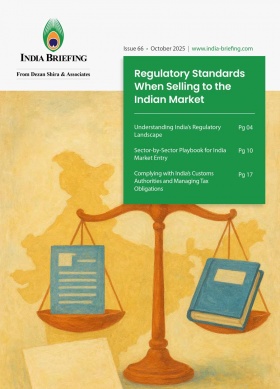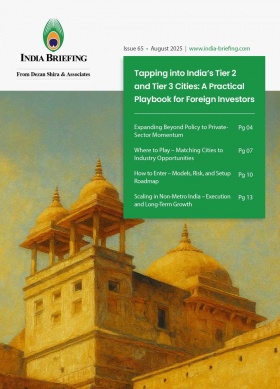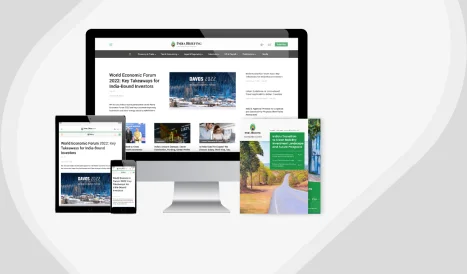How French Companies Leverage India as a Global Delivery Base
Learn how French multinationals leverage India as a global delivery base for IT, engineering, and manufacturing – combining scale, innovation, and 24-hour productivity.
India has evolved from a cost arbitrage destination into a high-value production and engineering springboard for French multinationals. In IT services and product engineering, in rolling stock and aerospace, and across electrical equipment and industrial automation, France’s champions now treat India as both a critical domestic market and a strategic global delivery base. The strategy mixes three ingredients: scaled talent pools, steadily improving productivity, and a “follow-the-sun” operating model that compresses European cycle times while maintaining quality.
Below, we map how leading French firms run India-anchored global delivery, what they deliver, and how executives can balance wage inflation with productivity to sustain advantages. We close with practical guidance on implementing a resilient Europe–India follow-the-sun model.
Also Read: India’s Global Capability Centers Market Estimated to Reach US$110 Billion by 2030
The scale-and-scope story: India as a production, engineering, and services hub
IT and digital services: France’s tech majors now run at Indian scale
- Capgemini: The French IT leader has become one of India’s largest private employers and continues to route more global work to India. As of September 30, 2025, Capgemini reported a total headcount of 354,700, with 211,800 in offshore locations; Indian hiring plans for 2025 alone are 40–45,000 people to build an AI-ready workforce, with media reporting roughly 175,000 employees in India already. Recent M&A also deepens India delivery roots. Capgemini’s acquisition of WNS (an Indian-origin Business Processing Management (BPM) specialist with most staff in India) strengthens end-to-end “intelligent operations” tied to AI and analytics.
- Societe Generale: Societe Generale Global Solution Centre (SG GSC) in India serves as a strategic global shared services hub for the Group and a key delivery platform for the Asia-Pacific region. Established in 2000, its Bengaluru and Chennai centers provide comprehensive support for Societe Generale’s worldwide operations. SG GSC offers a wide spectrum of solutions spanning Corporate and Investment Banking, Retail Banking, Specialized Financing and Insurance, Private Banking, and Global Investment Management Services. Societe Generale also operates an IFSC Banking Unit (IBU) at Gujarat International Finance Tec-City (GIFT City); the bank opened this branch in September 2025 to enhance its services for Indian clients.
- BNP Paribas: BNP’s India operations explicitly combine local business with technology and operations global delivery centers in Bengaluru, Chennai, and Mumbai, employing 14,000+ people. Recent real estate moves, like a large 145,000 sq ft lease in Thane, near Mumbai, reinforce long-term scale.
- AXA Global Business Services: AXA GBS has marked 30 years in India, serves 35+ AXA entities in 14 countries, and is pivoting from transactional work to an output-based, automation and data-led model from hubs including Bengaluru and Pune.
- Orange Business: Orange’s enterprise arm operates six major service centers covering all continents and positions India as a core location for connectivity, cloud, digital workplace, SIP voice and co-innovation in support of global capability centers.
Engineering, design, and product development: From captive centers to global R&D
- Valeo: A substantial share of the French tier-1 auto supplier’s engineering capabilities in hardware, software, electronics, materials, and cybersecurity is anchored in HQ Chennai. In 2025, the company expanded its Group Technical Centre (GTC) in the city, enhancing core competencies and reinforcing its role in supporting Valeo’s accelerated growth in the electric vehicle market. It operates eight production sites and a state-of-the-art global R&D center in India, strategically located across Chennai, Bangalore, Pune, Sanand, and Gurgaon. These facilities collectively employ almost 6,000 people, with 3,500 R&D engineers (about 1,700 in software).
- Renault Nissan Technology & Business Centre India (RNTBCI): Established in 2007, this Franco-Japanese captive automotive technology and business center supports global programs from Chennai/Mahindra World City with 10,000+ employees (engineering, IS/IT, and global business services), enabling rapid software, calibration, and process engineering loops for vehicles sold in Europe and other global markets.
- Dassault Systèmes: The company’s Pune campus houses R&D and the 3DEXPERIENCE Lab (established 2018) that accelerates startup innovation and advanced simulation skills serving global customers. Dassault also maintains Indian offices in Ahmedabad, Bengaluru, Chennai, Coimbatore, Kolkata, Mumbai, Gurgaon, and Pune.
- ALTEN: The French engineering, technology consulting, enterprise IT, and digital transformation company hosts the largest offshore delivery center for the group in India. Per the company’s website, ALTEN India spans over 8,700 engineers across 11 delivery centers in Bengaluru, Chennai, Pune, Hyderabad, Delhi, and Aurangabad, supporting aerospace, automotive, rail, telecom, and life sciences programs worldwide.
- Thales: Thales is headquartered in Noida and has other operational offices in Delhi, Bengaluru, Gurugram and Mumbai, among others. Two engineering competence centers in Noida and Bengaluru handle cyber/digital, hardware, software, and systems engineering for both civil and defense applications, delivering to global programs including avionics and inflight entertainment.
Industrial and electrical equipment: Exporting from India, digitizing factories, and building global supply nodes
- Schneider Electric: India is one of Schneider’s four global hubs. The company operates 31 factories and multiple distribution centers in India, with a public plan announced in 2025 to take full ownership of its Indian JV and expand capacity 2.5–3x, emphasizing India’s role as an R&D and supply-chain hub. Schneider’s Hyderabad smart factory is recognized by the World Economic Forum as a Sustainability Lighthouse, highlighting advanced 4IR capabilities and energy footprint improvements. New manufacturing investments are planned in Kolkata, Hyderabad, and Ahmednagar.
- Alstom: Alstom’s industrial network in India spans rolling stock and components. In March 2025, Alstom delivered the 500th electric locomotive to Indian Railways from its Madhepura (Bihar) site, while its Sri City plant builds metro trainsets for Indian and export markets.
- Safran: The group employs over 2,600 people across 18 sites in India, covering production, design, and services in the aviation, space, and defense industries. It is building one of its largest MRO facilities worldwide in Hyderabad for Leap engines, targeting full operations around 2025, backed by a €150 million investment.
- Airbus: Airbus has 3,600+ employees in India, sources >€1 billion annually in components and services and plans further growth to over 5,000 employees while deepening local manufacturing partnerships (including C295 with Tata).
WEF Global Lighthouse Network
Factories recognized as “WEF Lighthouses” are part of the World Economic Forum’s Global Lighthouse Network – a community of manufacturing sites that have successfully deployed Fourth Industrial Revolution (4IR) technologies, such as AI, robotics, IoT, and digital twins, at scale.
These “lighthouse” sites serve as global benchmarks for productivity, sustainability, and resilience, demonstrating measurable gains like higher output, reduced energy use, and faster innovation cycles. To qualify, facilities must prove real-world impact and the ability to replicate these results across their networks.
For industrial and engineering firms, especially those using India as a production or R&D base, achieving Lighthouse-level performance signals world-class operational excellence – where technology turns rising wage costs into rising productivity and global competitiveness.
Examples of lighthouse facilities in India set up by MNCs:
- Schneider Electric – Hyderabad, Telangana
Sector: Electrical equipment and industrial automation - Hindustan Unilever (HUL) – Dapada & Sonepat
Sector: FMCG manufacturing - Reddy’s Laboratories – Hyderabad
Sector: Pharmaceuticals - Cipla Ltd – Indore, Madhya Pradesh
Sector: Pharmaceutical manufacturing - ACG Group – Pithampur, Madhya Pradesh
Sector: Pharmaceutical machinery and capsule manufacturing - Procter & Gamble (P&G) – Hyderabad
Sector: Consumer goods / personal care manufacturing
The economics: Wage inflation vs. productivity
Leadership teams sometimes view India’s rising salaries as a threat to the offshoring equation. The reality is more nuanced and still favorable, provided companies aggressively invest in productivity.
Wage inflation: Rising, but moderating and predictable
- Aon’s Annual Salary Increase and Turnover Survey indicates 8.9 percent actual salary growth in 2025 and a 9 percent projection for 2026. These rates are lower than the post-pandemic peaks and are widely used by CFOs for annual workforce planning.
Productivity: Structural gains can outpace wages with the right operating model
- India’s tech sector continues to expand exports and value-added services. NASSCOM projects FY2025 industry revenue at ~US$283 billion, exports at ~US$224 billion, and total employment near 5.8 million, with momentum toward US$300 billion by FY2026. Engineering R&D and GCC expansion are key growth drivers, implying higher value per employee.
- McKinsey’s productivity research shows India contributing substantially to global productivity growth, with strong potential for further convergence. While national averages remain below G20 peers, the trajectory is positive when companies deploy 4IR systems, automation, and agile delivery at scale.
- At the plant level, Schneider Electric’s WEF Lighthouse accreditation in Hyderabad demonstrates measurable environmental and operational gains from digital twins, real-time energy management, and automated lines, which improve throughput per worker and shrink scrap and energy intensity.
What “global delivery from India” looks like in practice
Global IT and digital services
- Capgemini combines European client proximity with Indian scale. European discovery and architecture run in Paris, Munich, or Amsterdam; Indian teams in Pune, Hyderabad, or Bengaluru execute, then hand results back for stakeholder review in Europe. The WNS acquisition bolsters process orchestration and analytics at scale, enabling “technology plus operations” outcomes that reduce cycle times and total cost of ownership for European clients.
- Societe Generale and BNP Paribas use their India GBS/GSC organizations to standardize platforms and continuously deliver features and controls for global businesses, including risk, finance, payments, and markets. These hubs increasingly own product roadmaps rather than only ticket backlogs, reflecting a shift from cost centers to value generators.
- AXA GBS’s move to an output-based model illustrates how insurers can decouple headcount from throughput by investing in automation (RPA, data pipelines), modern software delivery, and platform squads, making wage inflation more manageable.
Engineering, design, and software-defined products
- Valeo in Chennai and RNTBCI in Chennai/MWC use India’s embedded software and systems talent to accelerate development of ADAS, electrification components, HMI, and calibration, feeding global vehicle programs bound for Europe.
- Dassault Systèmes’ R&D and 3DEXPERIENCE Lab in Pune foster startups and simulation expertise that European OEMs later consume via PLM and digital twin deployments, effectively turning India into a co-innovation engine.
- ALTEN provides a flexible bench of engineers across mechanical design, embedded, and digital engineering who can support European programs during crunch periods, thanks to a multi-city India footprint.
Industrial and aerospace production with 4IR
- Schneider Electric’s India factories export electrical equipment and energy-automation systems and serve as demonstrations of 4IR and circularity practices recognized by the WEF network, with a publicly stated plan to substantially expand capacity.
- Alstom’s Madhepura and Sri City sites build heavy locomotives and metro cars that support India and select overseas markets, validating India as a quality manufacturing base for advanced rail assets.
- Safran’s upcoming Hyderabad MRO will anchor lifecycle services for Leap engines in the region, complementing design and production centers and shortening maintenance turnarounds for European fleets operating in or through Asia.
Building a Europe–India “follow-the-sun” engine
Follow-the-sun (FTS) is a work relay that hands off tasks between time zones to maintain continuous momentum. Properly implemented, FTS makes Europe faster without heroics or burnout.
Authoritative guides define FTS as daily, structured handoffs across distant time zones, aimed at reducing development duration and increasing responsiveness. It is distinct from simple 24/7 availability or colocated shift work. However, fragile processes, weak documentation, or culturally siloed teams can make FTS stumble.
A COO/CFO checklist:
- Automate the toil: Invest in developer experience (DevEx), golden pipelines, and platform engineering.
- Upskill for value density: Shift mix toward higher-value roles (SRE, data engineering, embedded software, cyber).
- Standardize handoffs: Borrow proven FTS handbooks and tailor to your program; mandate runbooks and acceptance criteria to avoid overnight ping-pong.
- Exploit 4IR plants and circularity: Use India’s Lighthouse factories as training grounds to scale digital twins and energy optimization globally. E.g., Schneider Electric’s Hyderabad factory
- Diversify within India: Spread delivery across Chennai, Bengaluru, Pune, Hyderabad to buffer attrition spikes and wage pressures. Leading French firms already do this.
- Benchmark annually: Use reliable industry salary surveys and internal productivity dashboards to reassess your business case each year. Incorporate updated compensation trends and assume an ‘X percent’ salary growth baseline for accurate financial and workforce planning in the current cycle.
- Attrition and tacit knowledge loss: Mitigate with documented runbooks, shadow rotations, and skills matrices across locations.
- Cross-site misalignment: Establish a single product backlog, where all teams, regardless of geography, should pull tasks from one shared list of priorities. Use “two-in-the-box” leadership, which pairs two leads – typically one in each key geography (for instance, a product owner in Paris and a delivery lead in Bengaluru). They share accountability for outcomes, coordinate decisions, and bridge cultural or time-zone divides. Implement synchronized PI planning, which brings all teams together, virtually or physically, to plan upcoming work for a set period (often 8-12 weeks). This ensures priorities, dependencies, and timelines are aligned from the start, preventing mid-cycle surprises.
- Supply-chain exposure: For industrial firms – multi-source critical components; leverage India’s maturing vendor base around French OEM facilities.
- Regulatory and data residency: Keep an eye on India’s data protection regimes and sectoral norms; architect for data localization where needed and use zero-trust patterns for multi-region access.
A European manufacturer’s example pattern:
Consider a French OEM digitizing a power-electronics product line.
- Morning in Lyon: Architects and product owners approve epics and feature slices.
- Afternoon in Lyon: Create the handoff packet; update Jira/Polarion, attach models and acceptance criteria.
- Day in Bengaluru/Chennai: Indian engineering teams implement testable increments, run continuous integration (CI), publish dashboards, and open issues by 3 p.m. IST.
- Next morning in France: Review and merge, trigger hardware-in-loop tests, and plan the next slice.
Why India is becoming a vital global delivery base for European firms
India’s IT exports rebounded sharply to US$224.4 billion in FY2024-25 and the sector is on track toward US$300 billion revenue in FY2026, propelled by engineering R&D and the rise of GCCs. Meanwhile, WEF Lighthouse practices, expanding French manufacturing footprints, and the deepening of captive tech and operations centers indicate that India’s role has shifted from “back office” to a front-line innovation and production node.
For European executives, the implication is clear: use India not only to lower cost, but to shorten time to market, improve resilience, and expand your talent frontier. The follow-the-sun relay is the gear that meshes these advantages into measurable business outcomes.
About Us
India Briefing is one of five regional publications under the Asia Briefing brand. It is supported by Dezan Shira & Associates, a pan-Asia, multi-disciplinary professional services firm that assists foreign investors throughout Asia, including through offices in Delhi, Mumbai, and Bengaluru in India. Dezan Shira & Associates also maintains offices or has alliance partners assisting foreign investors in China, Hong Kong SAR, Vietnam, Indonesia, Singapore, Malaysia, Mongolia, Dubai (UAE), Japan, South Korea, Nepal, The Philippines, Sri Lanka, Thailand, Italy, Germany, Bangladesh, Australia, United States, and United Kingdom and Ireland.
For a complimentary subscription to India Briefing’s content products, please click here. For support with establishing a business in India or for assistance in analyzing and entering markets, please contact the firm at india@dezshira.com or visit our website at www.dezshira.com.
- Previous Article Why India is Becoming the Offshore Accounting Hub for Global CPA Firms
- Next Article Navigate India’s STP and EHTP Frameworks: Benefits and Registration Process








